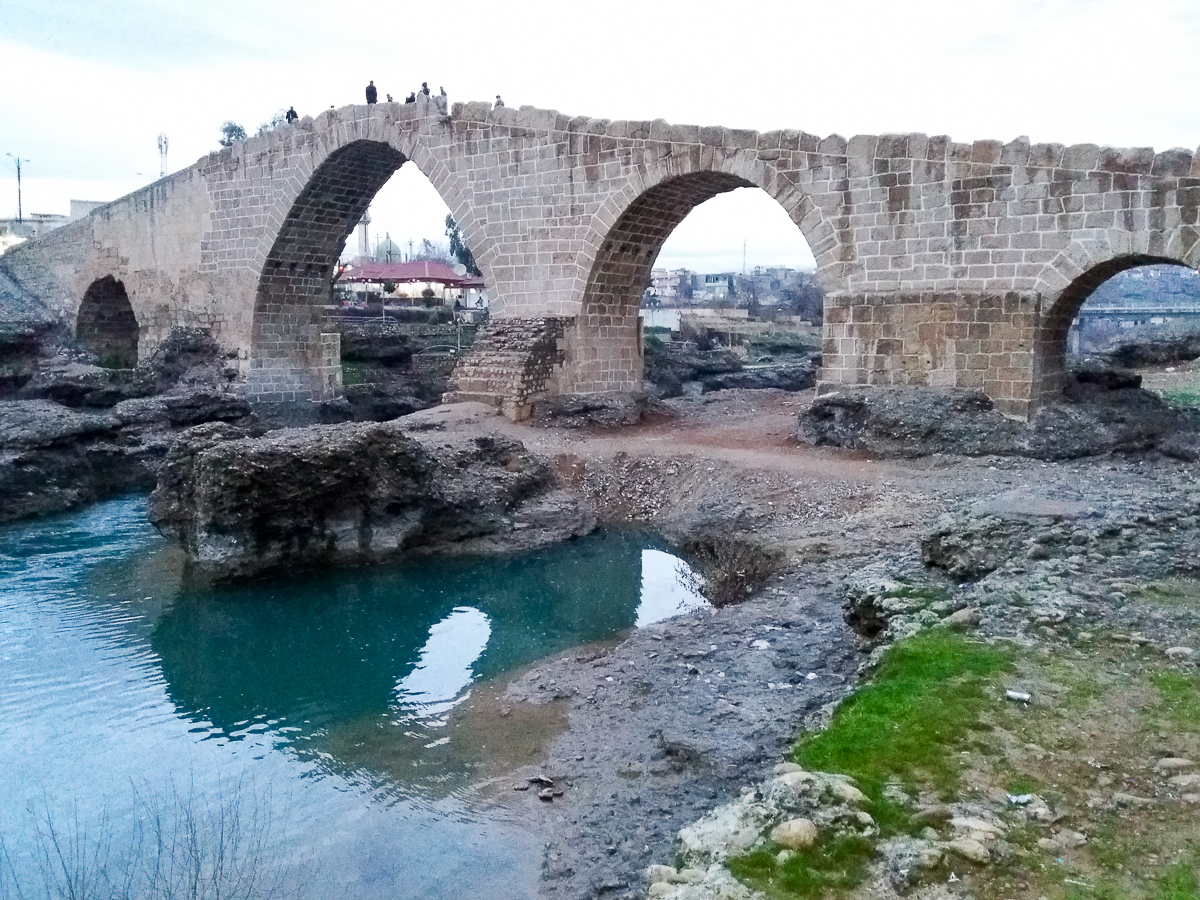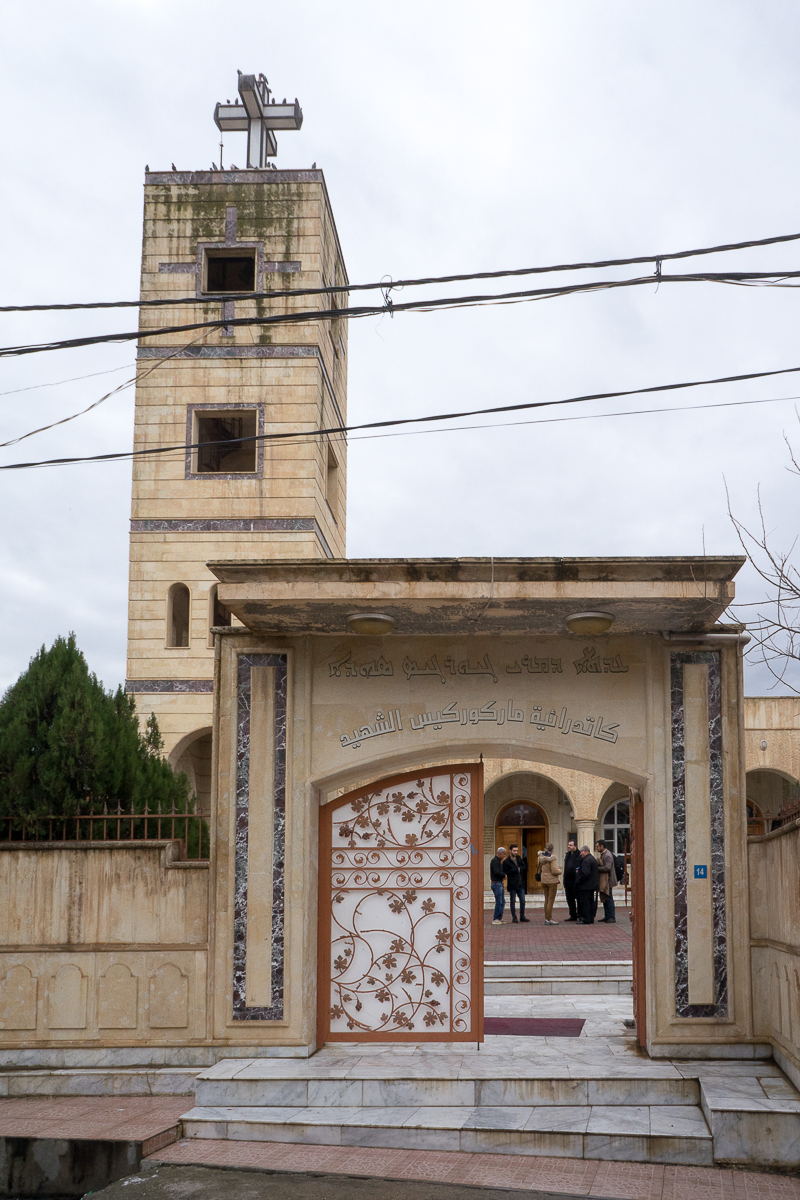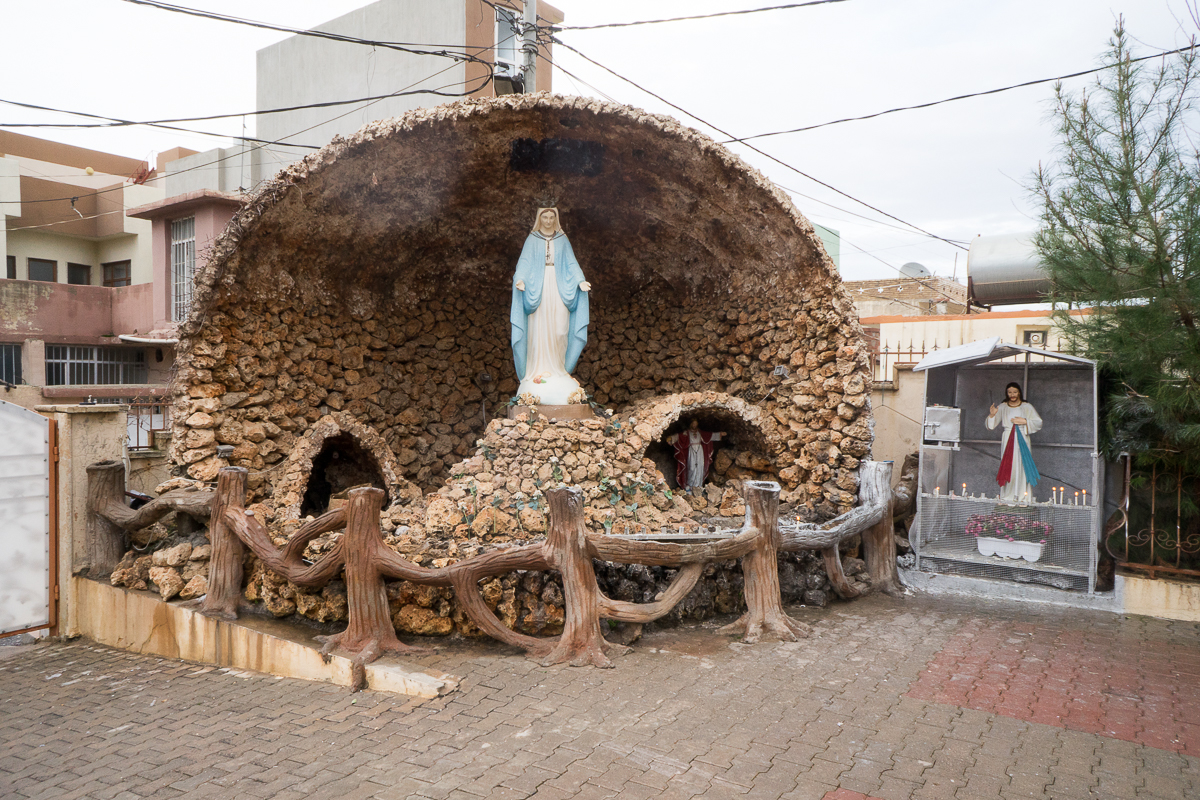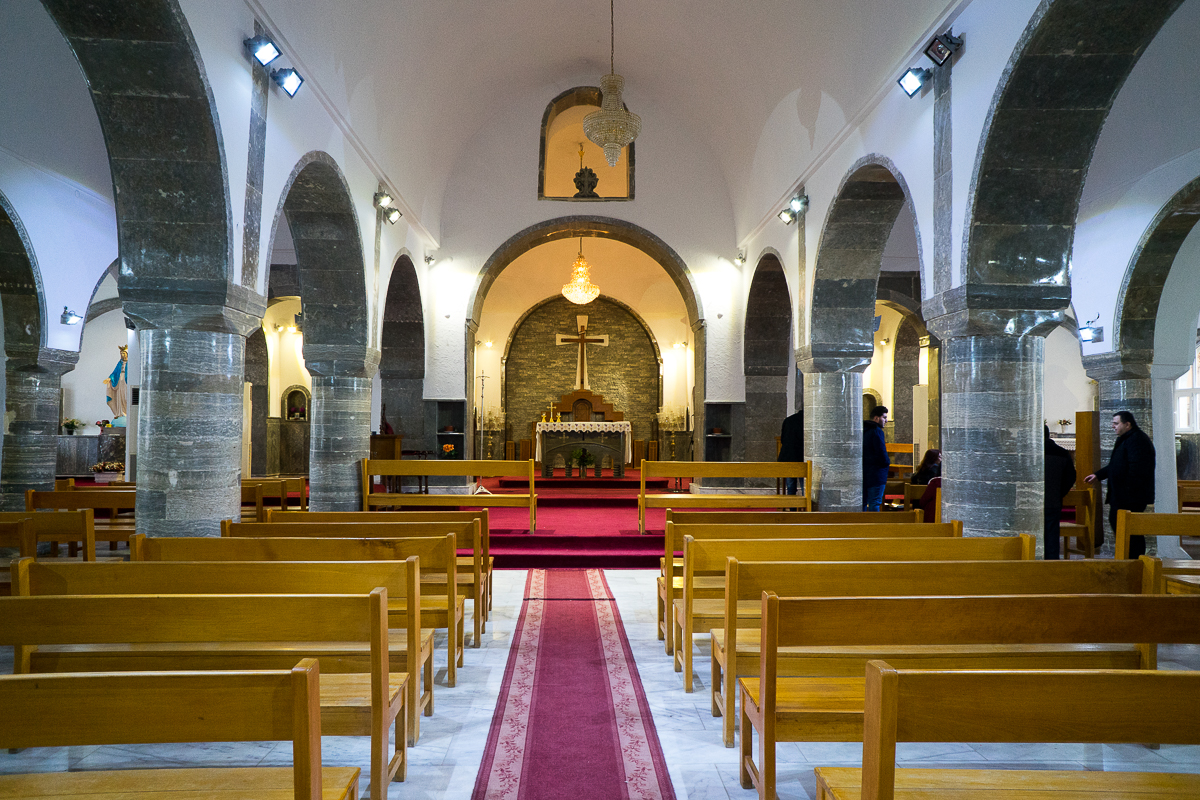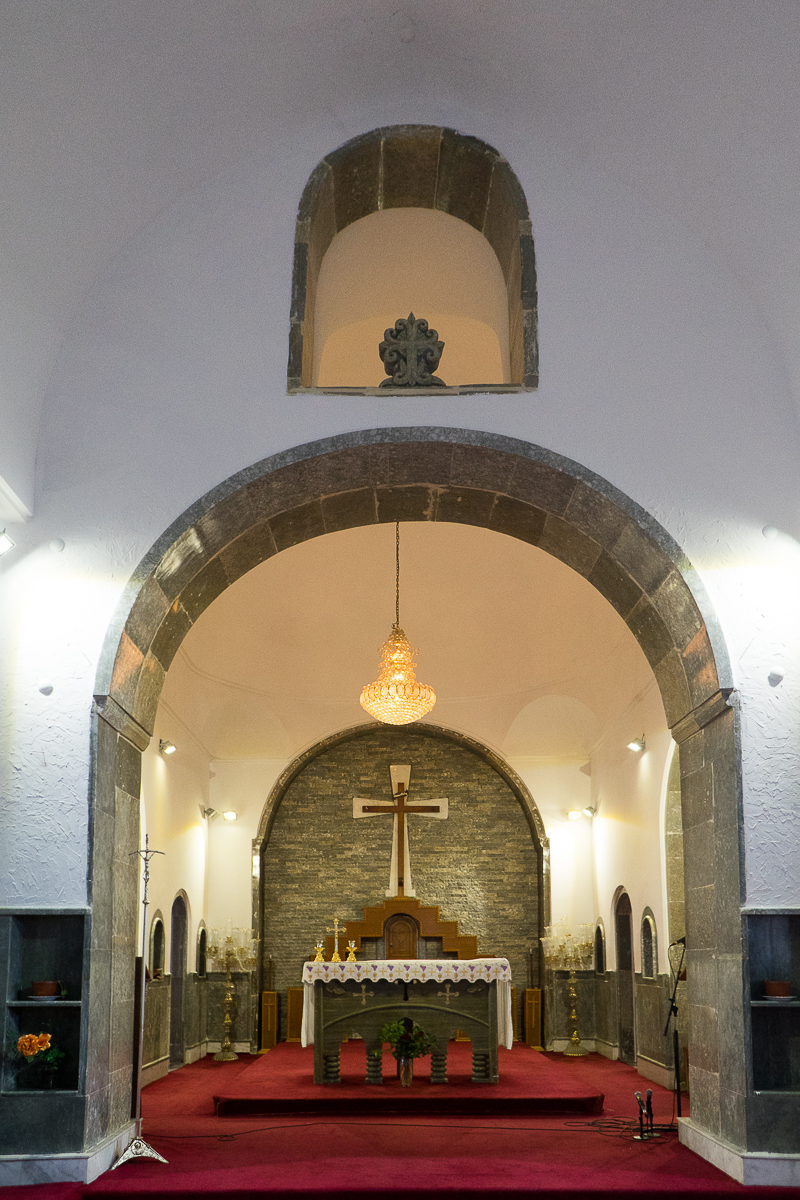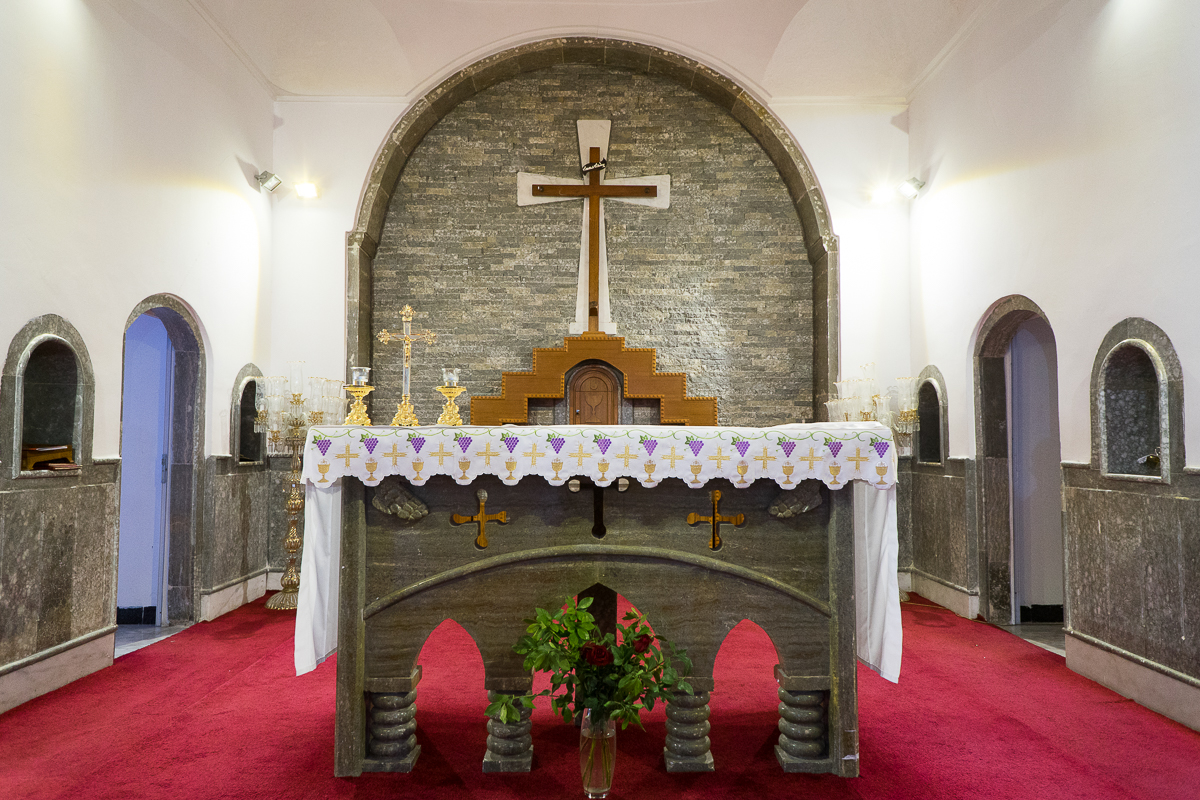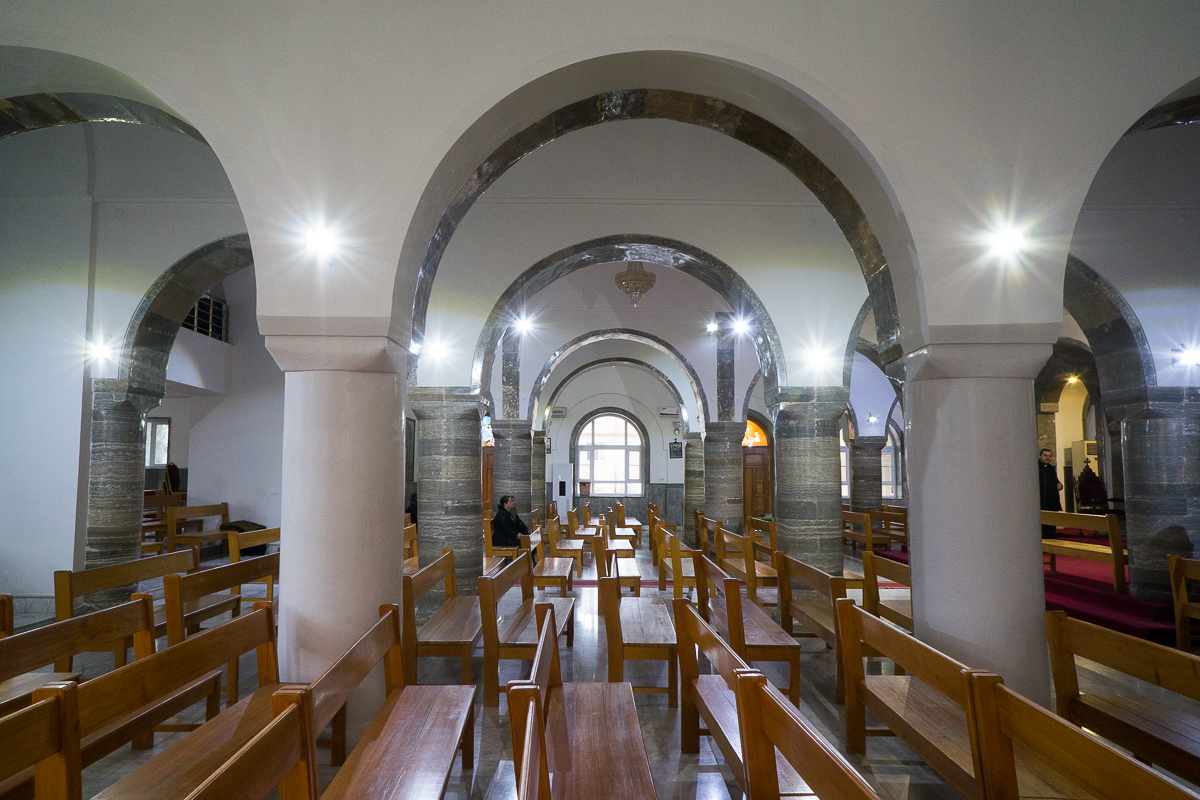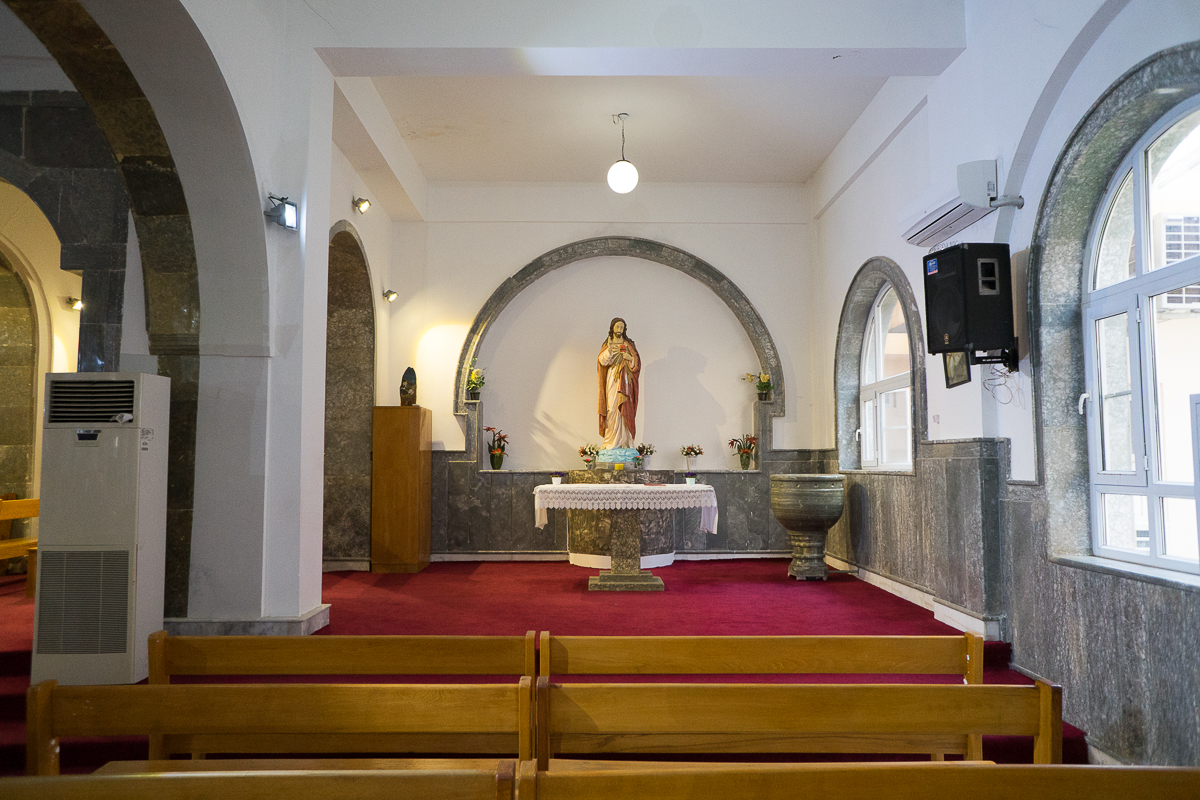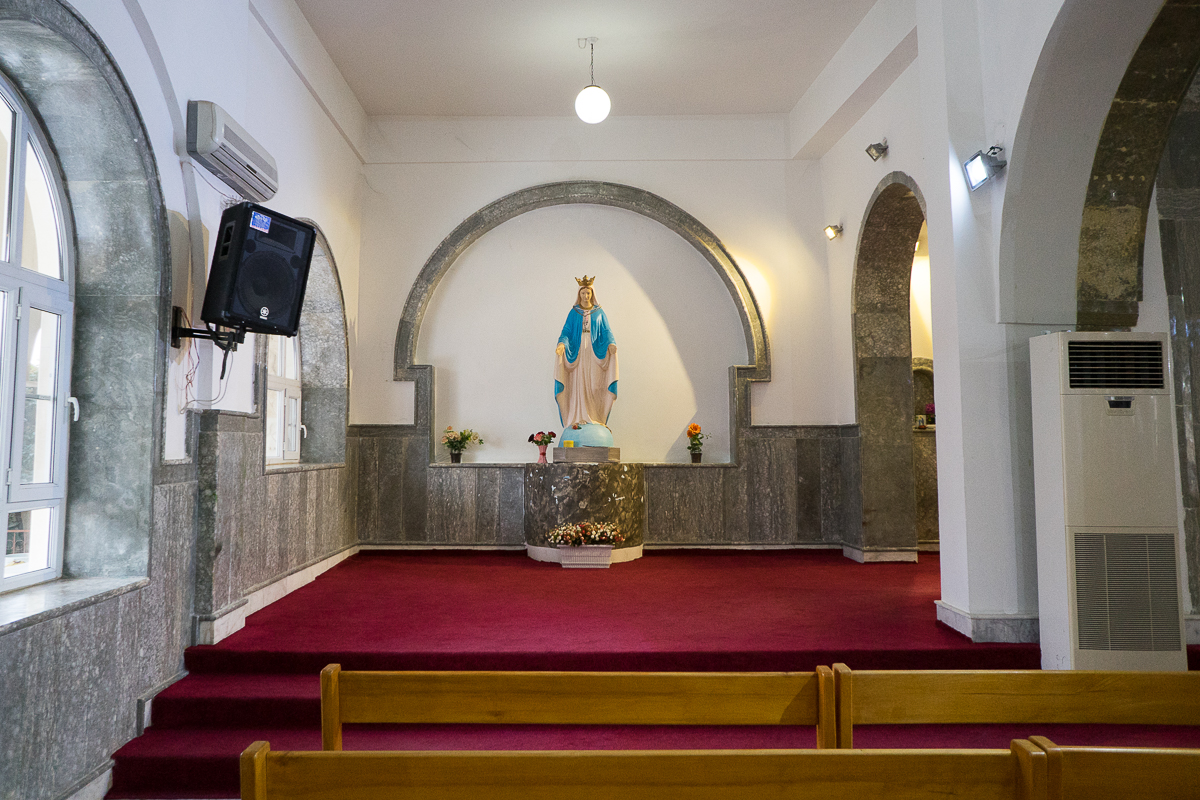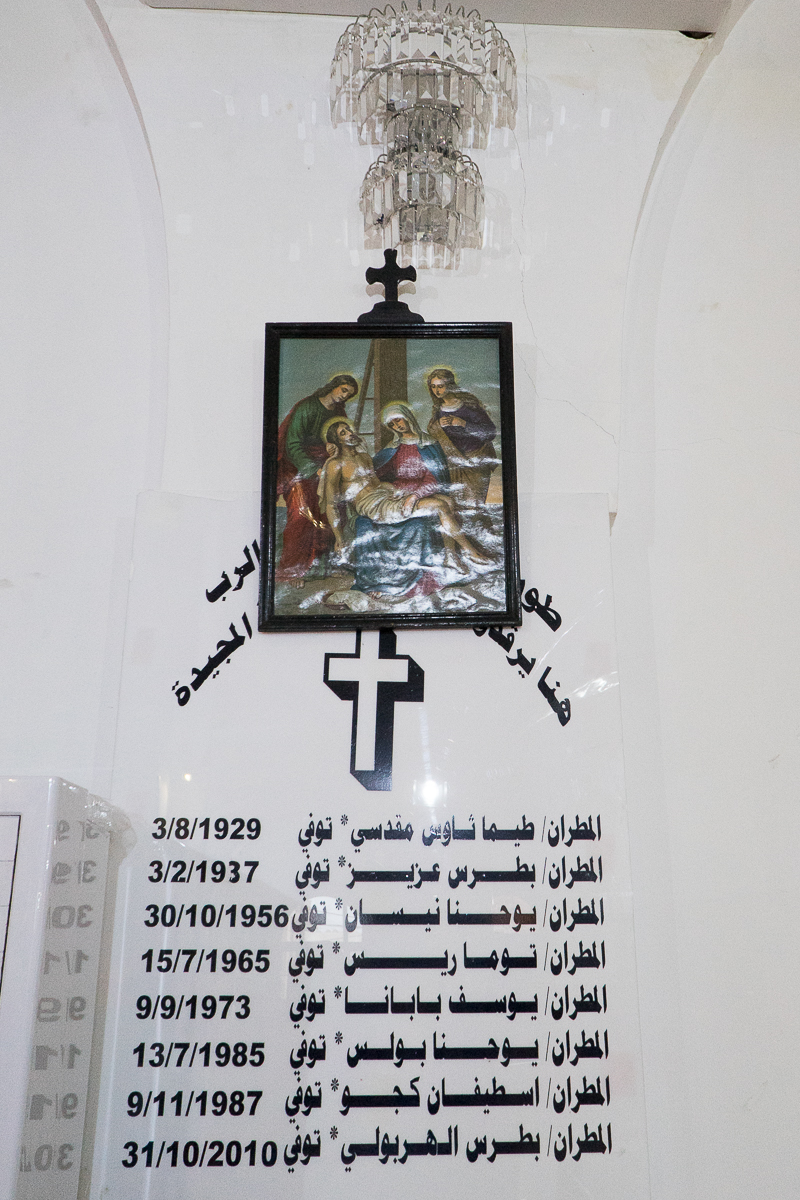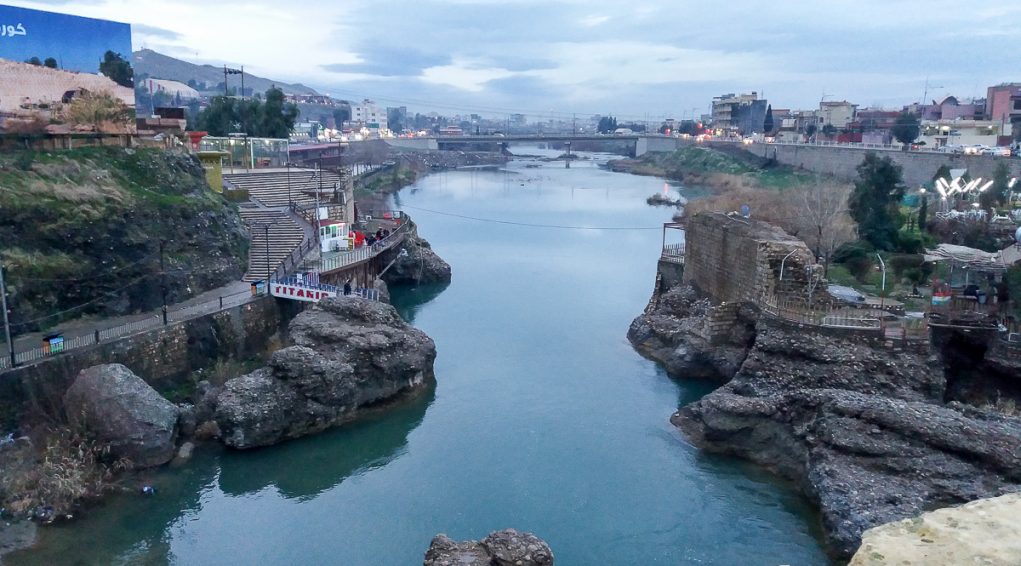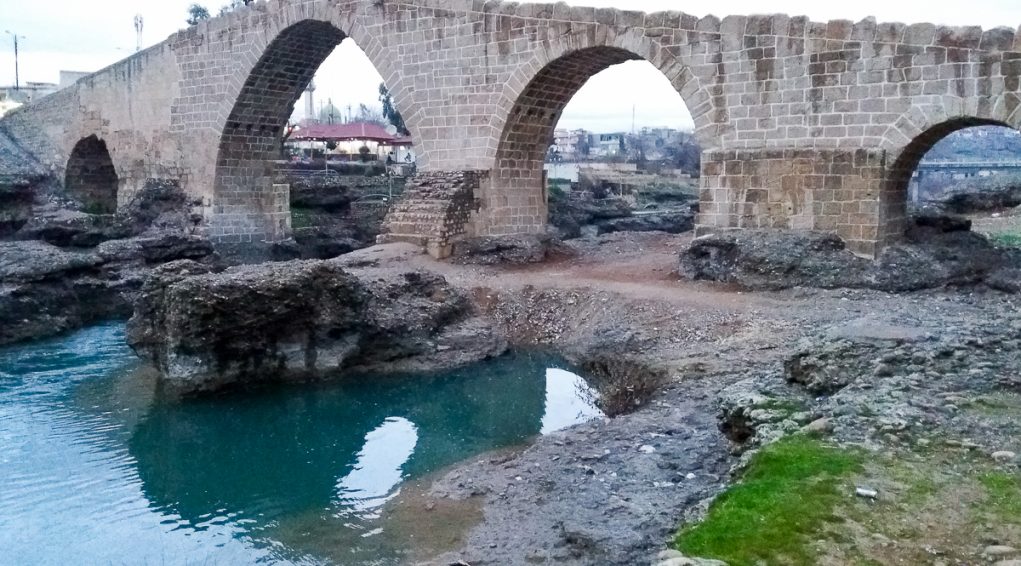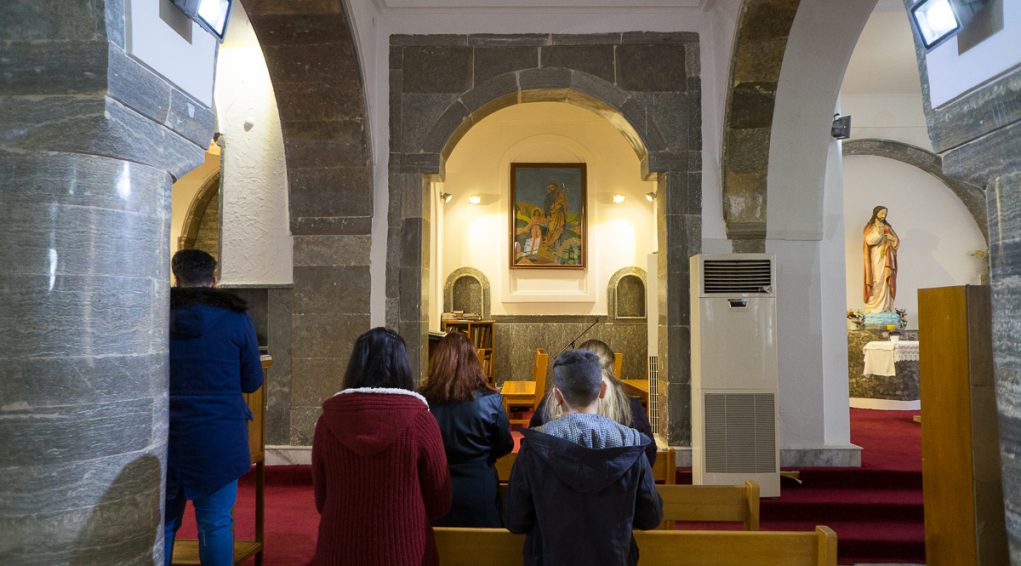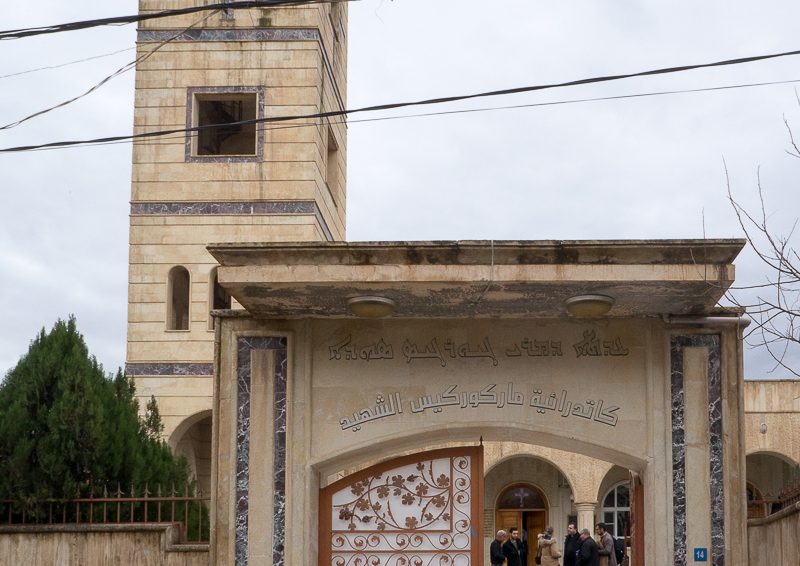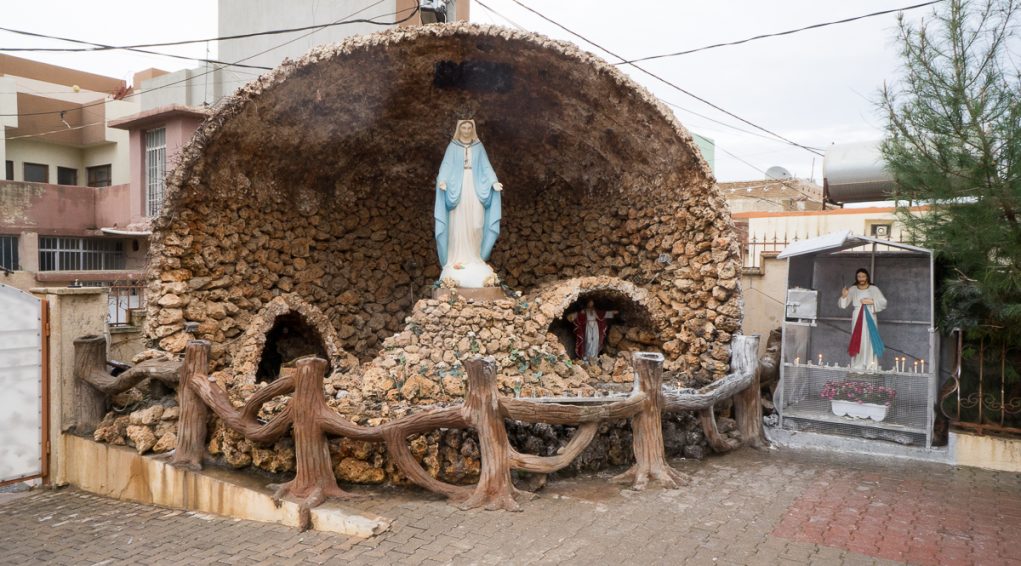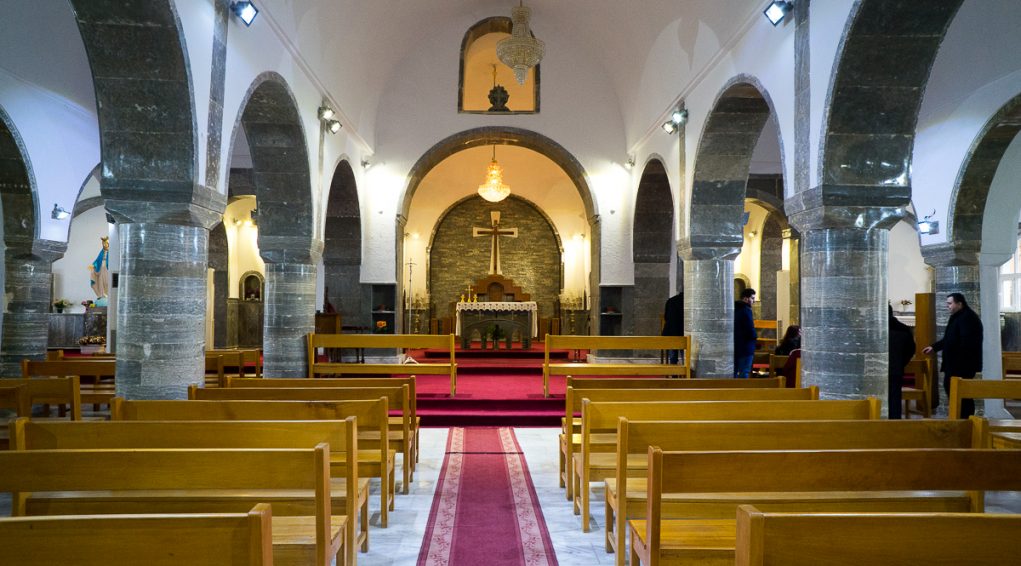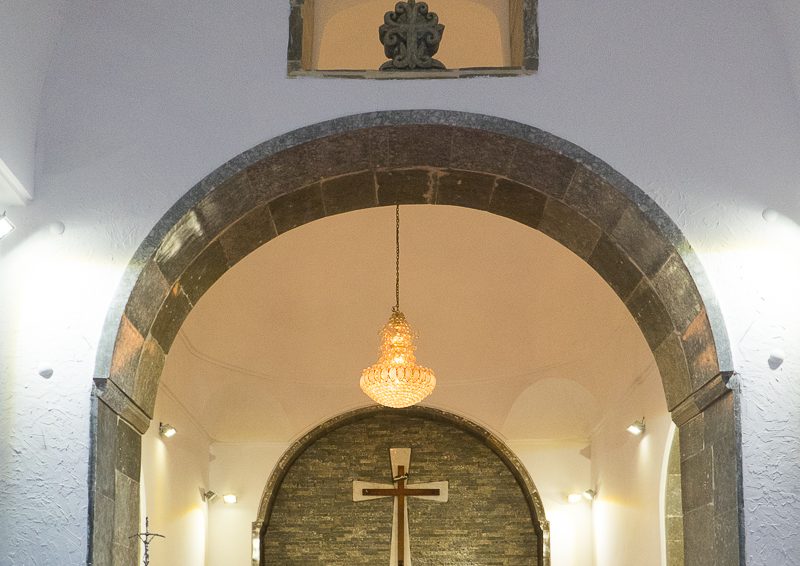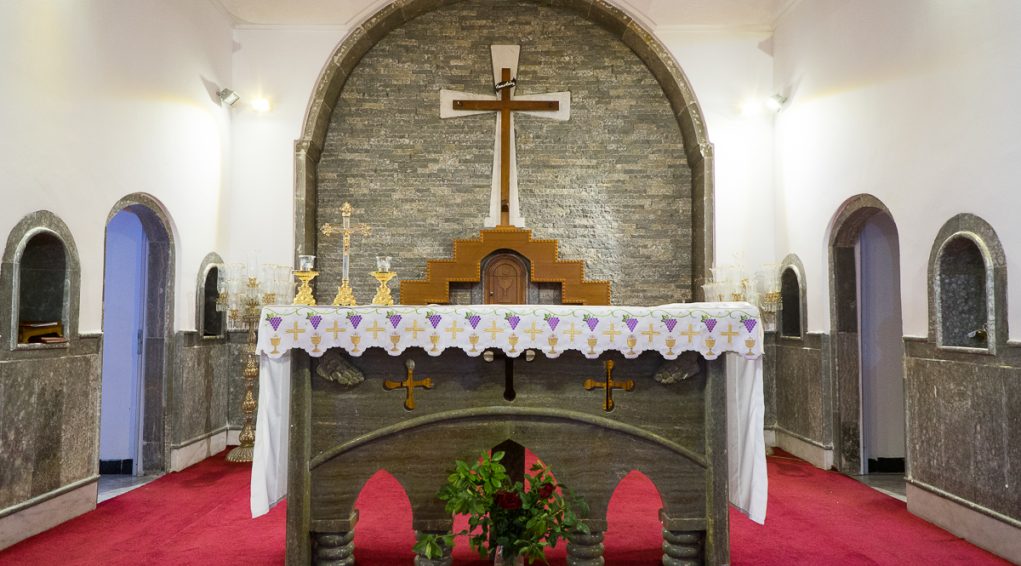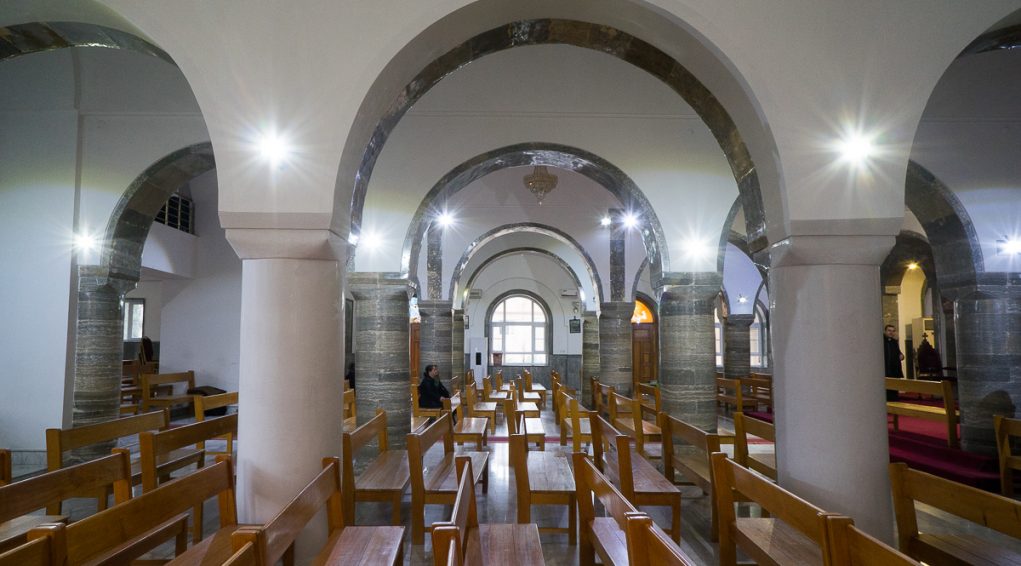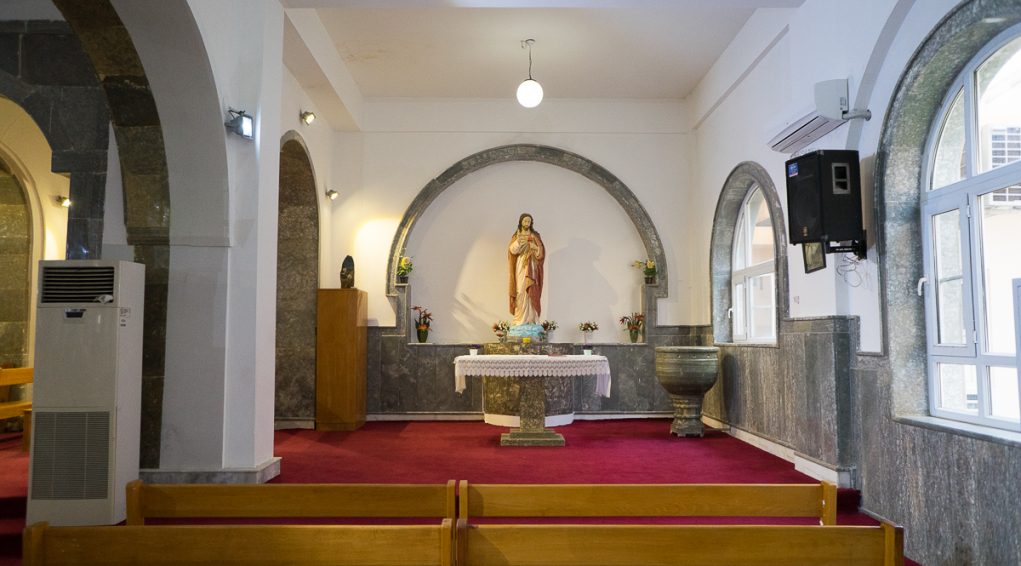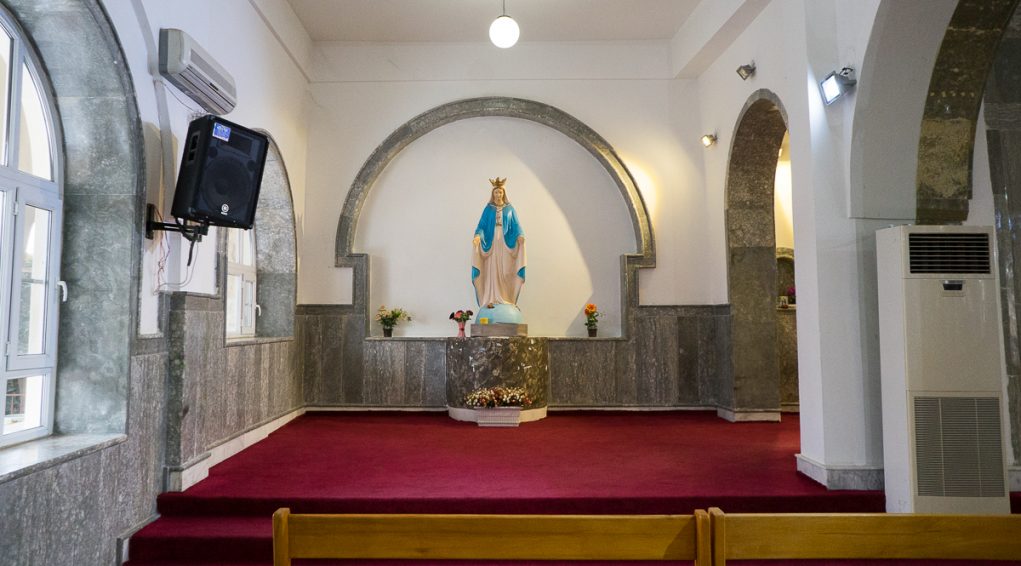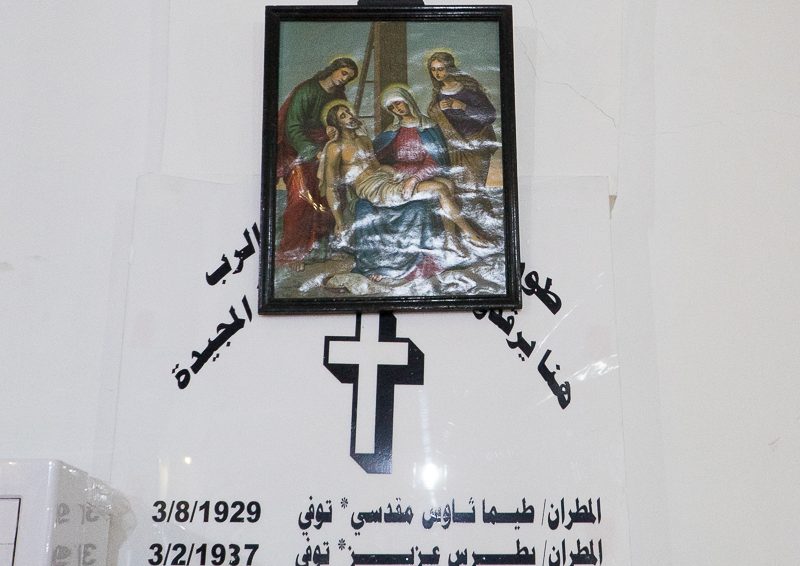The Mar Gorgis Cathedral in Zakho
The Mar Gorgis cathedral is located in Zakho, at 37°08’27.6″N 42°40’39.6″E and 440 metres altitude, close to the Turkish and Syrian border.
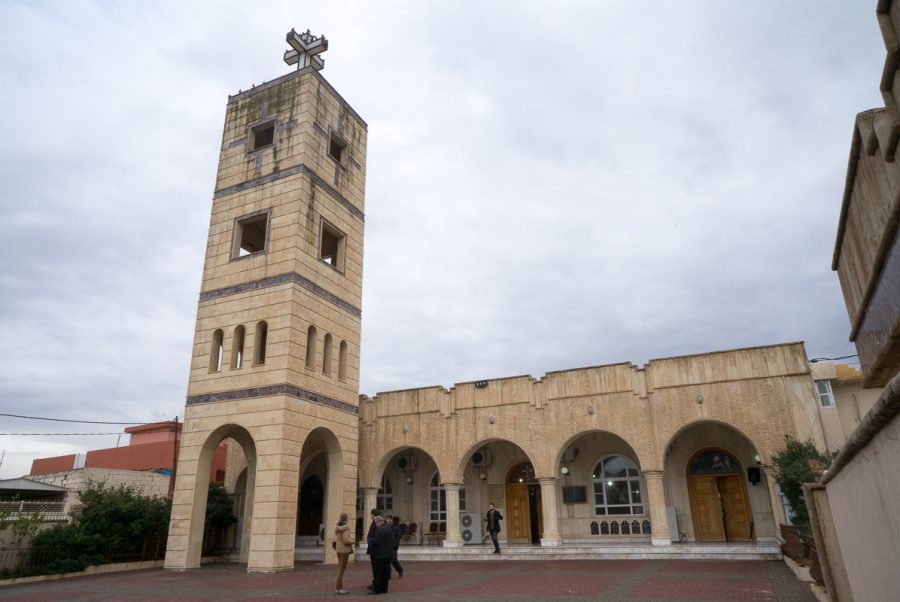
There are no traces of Zakho’s ancient churches. Those visible today are all relatively recent. There are three Chaldean churches in Zakho: the Mar Gorgis cathedral in the Nasara district, the Mariam al Adra church in the Abassia district, and the Sacred Heart church in the Bidar district.
The Mar Gorgis cathedral was built in 1911 by bishop Jérémie-Timothée Makdassi who wanted to establish a new Chaldean episcopal seat. This cathedral church has been renovated and modified several times. Rather than proceeding with an approach typical of Iraqi heritage, i.e. demolishing the ancient to build something entirely new, this church was built with a series of additions. This explains its astonishing five-nave structure.
Pic : The Chaldean Mar Gorgis cathedral in Zakho. February 2018 © Pascal Maguesyan / MESOPOTAMIA
Location
The Mar Gorgis cathedral is located in Zakho, in the Nasara district, at 37°08’27.6″N 42°40’39.6″E and 440 metres altitude.
Zakho is the largest Iraqi town on the Turkish and Syrian border. It is located just 6 kilometres east of the main Ibrahim Khalil border crossing into Turkey and 30 kilometres east of the Tigris on the far eastern border of Syria. Zakho therefore occupies a key strategic position
Fragments of Christian history
The Christian history of Zakho is very similar to that of other villages of the area. Pre-existing Jewish presence and early evangelization under the influence of apostles Thomas, Addai (can also be the apostle Jude, also known as Thaddeus in the Gospel) and Mari. Throughout a 4th century full of vocations, the tradition relates many stories of martyrs persecuted by the Persian king Shapur II. And all along these times of the first Christians, hermitages and primitive sanctuaries developed, at the very same place where Assyrian churches and monasteries progressively raised. Throughout the centuries and until the fall of the Ottoman Empire, the valleys and the mountains which edge this part of Mesopotamia were a place of fulfilment and protection for the Church of the East, on both sides of the modern Iraq-Turkey border where catholic missions flourished from the 17th century onwards with a surge in the 18th century. Up until 1850, Zakho, Akra and Amadia formed one single Chaldean diocese called Amadia. It was at this time that they were divided into three separate archdioceses[1]. This community and denominational context was overturned at the end of the 19th and start of the 20th century with the persecution of the Kurds, the implementation of Seyfo[2]by the Young Turks and the dismantling of the Ottoman empire.
During the rest of the 20th century, and although the Iraqi administration took the lead from 1921, the Chaldeans had no respite. Between 1961 and 1991, the successive wars which opposed the Iraqi government and the Kurdish peshmerga weighed heavily on the Christian communities and their heritage. “In the Zakho diocese alone – one of the two dioceses of Badinan, along with Amadia – 30 Chaldean villages and 40 churches were razed to the ground: outside of Zakho and Dohuk only five villages remained! The most ancient churches, some over ten centuries old, were destroyed and others, such as Beidar on the outskirts of Zakho, are in a pitiful state: after being used as barracks by the Iraqi army up until spring 1991, it is now used as… a stable.[3]”There are no traces of Zakho’s ancient churches. Those visible today are all relatively recent, regardless of their denomination. In the governorate of Dohuk-Nohadra, where Zakho is situated, “if we say that if one hundred churches were blown up (the real figure is of course much higher) this would mean at least two hundred inscriptions would be lost.[4]” ISIS may not have reached Iraqi Kurdistan, but “the outcomes of the Saddam era were terrible for the Christian community in Kurdistan.” The so-called protector of the Christians of Baghdad and Basra wiped out the Christian community in Kurdistan. Dozens of extremely ancient churches, rare evidence of the origins of Christianity, were destroyed. Dozens of Christian villages were razed to the ground and their populations deported. Whatever the future for holds for Kurdistan, despite reconstruction attempts, this world has disappeared forever, nothing will bring back the tens of thousands of Christians who emigrated to the west and are now living in Europe or the New World.”[5]
_______
[1]In « L’Église chaldéenne catholique, autrefois et aujourd’hui ».Extract from the Annuaire Pontifical catholique de 1914, Abbé Joseph Tfinkdji, Chaldean Priest in Mardin, p.70
[2]Seyfo is the Syriac name for the Assyrian Chaldean and Syriac genocide in the Ottoman Empire in 1915-1918.
[3]In Croissance, 1995, Chris Kutschera. https://www.chris-kutschera.com/chretiens_irak.htm.It should be noted that the Beidar (Bidar) church was renovated and is again used for services.
[4]In « Recueil des inscriptions syriaques », tome 2, Amir Harrak, Académie des inscriptions et belles lettres, 2010, p.533
[5]In « Le livre noir de Saddam Hussein », Chris Kutschera, Oh Éditions, 2005, p.398
Christian demographics in Zakho
In 1914, there were 50 Chaldeans in Zakho[1]. At the start of the 1960s, before the start of the war between the Iraqi government and the Kurdish peshmerga “the population of the city of Zakho was made up of 45% of Christians.[2]”In 1985, “the cathedral parish of Zakho numbered 600 people[3]” which grew to 1,500 in 1987 due to operation Anfal which targeted rural areas and increased the Christian populations in large cities before “decreasing to 1,176 in 1990.”At the end of the 1990s, the resettlement of displaced Christians from Mosul and Baghdad in the Nineveh plain again increased the Chaldean population in Zakho. It reached 675[4]families (around 3,400 people) in 2005, but in 2017 only 360 Chaldean families remained in Zakho[5](around 1,800 people). This most recent reduction was due to migration for economic rather than security reasons.
_______
[1]In « L’Église chaldéenne catholique, autrefois et aujourd’hui ».Extract from the Annuaire Pontifical catholique de 1914, Abbé Joseph Tfinkdji, Chaldean Priest in Mardin, p.72
[2]In « Le livre noir de Saddam Hussein », Chris Kutschera, Oh Éditions, 2005, p.394
[3]In « Le livre noir de Saddam Hussein », Chris Kutschera, Oh Éditions, 2005, p.396
[5]Information collected in February 2017 by the Mesopotamia team from Father Johny Daoud Hanna, archpriest of the Mar Gorgis cathedral and episcopal vicar of the diocese of Zakho.
History of the Mar Gorgis cathedral in Zakho
There are three Chaldean churches in Zakho: the Mar Gorgis cathedral in the Nasara district, the Mariam al Adra church in the Abassia district, and the church of the Sacred Heart in the Bidar district.
The Mar Gorgis cathedral was built in 1911 by bishop Jérémie-Timothée Makdassi who wanted to establish a new Chaldean episcopal seat. It was built at the same time as the archdiocese, next to the cathedral. Before Mar Gorgis was built, there was no Chaldean church in the Nassara district. The life of the Chaldean diocese centres around the Bidar district.
This cathedral church has been renovated and modified several times. Rather than proceeding with an approach typical of Iraqi heritage, i.e. demolishing the ancient to build something entirely new, this church was built with a series of additions. This explains its astonishing five-nave structure. In reality, Mar Gorgis was originally much narrower. It was extended for the first time at the time of bishop Stepanos Katcho, with the construction of a tribune (to the west) aligned with the sanctuary. It was then enlarged to the north and the south with the addition of new side aisles at the time of bishop Petros Harboli. The major renovation work he undertook at the start of the 2000s was funded by the benefactor and minister in the Iraqi Kurdish regional government Sarkis Aghajan, and the renovated cathedral was consecrated a second time.
Father Johny Daoud Hanna, episcopal vicar of the diocese of Zakho is the archpriest of the Mar Gorgis cathedral. [1]
_______
Description of the Mar Gorgis cathedral in Zakho
The Mar Gorgis cathedral stands on a plot of land closed off by a perimeter wall. On the left of the entrance gate to the vast esplanade in front of the church is a reproduction of the cave of Lourdes, constantly piled high with signs of worship of the Virgin Mary.
Viewed from the exterior, the most impressive part of the Mar Gorgis cathedral is its square-based three-storey bell tower. The building has a terrace roof. Two doors under a gallery of arches provide access to the building via the north side aisle.
Inside, the cathedral is both massive and elegant. The basilica-style architecture with five naves is organized symmetrically, either side of the central nave mounted with a semi-circular barrel vault. The two side aisles, to the north and the south, date from 1911. They are separated from the central nave with thick semi-circular arches which connect three pairs of freestanding cylindrical pillars in Mosul marble. The side aisles added at a later date to the north and south extremities are supported by columns, on the original load-bearing pillars.
The royal door to the sanctuary forms a semi-circular arch and is mounted with a niche containing a very ancient Assyrian stone cross.
The marble is well cared for and remarkably shiny. The walls are covered with a white rendering, which makes the interior even brighter.
The sanctuary has been renovated and enhanced. It contains a beautiful marble high altar. The side altars are dedicated, as is traditional, to Saint Joseph and the Virgin Mary.
The southern side aisles contain the tombs of the eight bishops who served the diocese of Zakho since Monsignor Jérémie-Timothée Makdassi through to Monsignor Petros Harboli.
The feast day of the Mar Gorgis cathedral on 24 April is traditionally a time of celebration and a meal shared by the whole community.
Monument's gallery
Help us preserve the monuments' memory
Family pictures, videos, records, share your documents to make the site live!
I contribute
